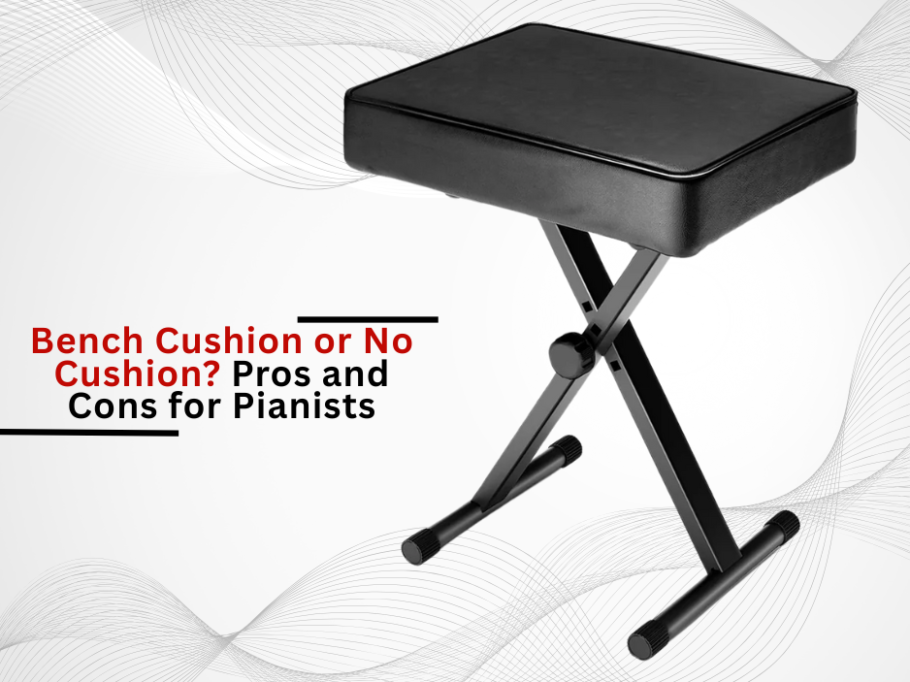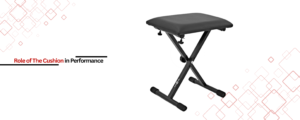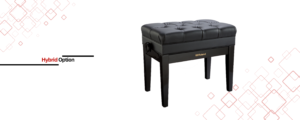The debate on whether a piano bench should have a cushion or not has perplexed musicians for decades. While some pianists enjoy the comfort cushions provide, others seem to think that firmer surfaces are better for posture or technical work. This article aims to assist those who want to tailor their seating preferences to their physiological needs and creative desires by discussing the pros and cons of each option.
To know more, Read: Top Picks for Keyboard and Piano Benches in 2025
Role of The Cushion in Performance
The type of bench selected influences the way a pianist maintains posture, grip strength, and overall control. Adding the possibility of cushioning to a bench makes it a lot more complex. Different pianists seek varying levels of cushioning due to practice habits, body mechanics, and personal sensitivity to aesthetics.
1. Pros of Cushioned Bench:
Improved Comfort During Extended Practices:
Using a cushion helps ease pressure placed, making it comfortable to sit for sustained periods. It has been noted that gel-infused or memory foam padding makes sitting for long durations much easier.
Aids in Greater Control of Sweat and Heat Removal:
During heated bouts of play, certain areas such as the back of the chair may need to have a lot of heat released from the mesh or perforated leather fabrics.
Access to Support for Disabled Groups:
Musical performers with mobility disorders like arthritis and sciatica seem to prefer pedal-spring instruments because the padding tends to soak up impact, thus reducing stress on the joints.
2. Cons of a Cushioned Bench:
Risk of Slouching:
Encouraging proper shoulder and spine alignment will enable yawning and closing of flippers—technical agility—with chronic pain issues from slumping.
Less Balanced:
Less fitted, thicker cushions are less stable. Extra movement with the pianist’s vigorous playing can disturb pedal control and dynamic precision.
Maintenance Challenges:
Stain Removal Constant scrubbing to keep these from looking stained or smelling bad is difficult when foam is fixed. This problem gets worse in humid climates.
1. Pros of an Uncushioned Bench:
Best for Placing Skeletons in Correct Positions:
The likelihood of placing soft, rounder foam on the shoulder and back toward flexing. A stuck posture means stiff precision, which, mostly, a rigorous, classically trained surgeon would greatly benefit from.
Added Tactile Feedback Enhancements:
The weight shifts through movements of the legs, arms, and torso enable changes in center of gravity to contour with the instrument for easier contact.
Simplicity in Design and Durability:
Natural and metaphoric woods are carved into sleek, sculpted benches that often lack cushioned tops but require no maintenance for decades. Streamlined design is meant to blend with simplistic interiors but aesthetically goes unnoticed.
Optimal Postural Alignment:
Soft foam increases the likelihood of rounding shoulders and curving back. Locked-in posture results in stiff surgeons’ precision, especially enhanced for those for whom classical training is preferred.
Need this in bulk? You can get this from wholesale – piano benches
If you need this at the best prices, you might check out this new platform – piano benches
2. Cons of an Uncushioned Bench:
Optimal Posture Alignment:
Sitting for extended durations on hard surfaces leads to pressure sores or aching in bony areas prone to bearing weight, like the sit bones or tailbone.
Higher Agility:
Pianists who require tilt adjustments or lumbar support are out of luck, as the sturdy, uncushioned model offers no relief.
Aesthetic Design Flexibility:
Benches with no padding do not warm or soften commingled design styles, thus decreasing design elasticity.
Hybrid Option: Bridging the Divide
For pianists who are caught up between supporting their posture, hybrid benches offer an alternative in comfort.
- Interchangeable Cushions: Provide temporary softening during lengthy sessions.
- Sculpted Hard Surfaces: Wooden benches crafted with gentle slopes supplant soft ergonomic support.
- Adjustable Firmness: Some modular designs allow users to change the thickness or density of the cushions.
Factors to Guide Your Choice
Duration of Practice:
Longer sessions will require form-maintaining while exercising with balanced pillows and softer slabs.
Nature of Playing:
Musicians focusing on contemporary or jazz music and swift motions may prefer stability, while classical players may lean towards prioritizing the posture of the equipment utilized.
Health Requirements:
Chronic conditions such as herniated discs or restricted body circulation will almost always need the use of extra padding.
Conclusion
It all comes down to personal priorities as they combine artistic needs with physical requirements in the cushion debate. Roland, 5 Core, and Gleam are brands that showcase different solutions in the market and aim to serve both traditionalists and modernists. While some pianists flourish in the discipline of a hard surface, others find freedom in softness. Designs of the future may blur these separations further as ergonomic research progresses, but the heart of the option will always be balanced within the individual. In finding equilibrium between comfort and control, pianists find a way to ensure their seating does not transform into an obstacle but instead, an instrument in the performance, synchronizing with every note.



